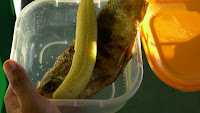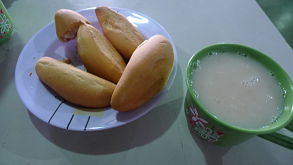 |
| The view from top bunk cabin 1 Tuky III |
Reading the guidebooks as we motored down the Ucayali towards Iquitos, (or up, since we were going generally north!) I learned that more than half the land of Peru is spread out flat to the east of the Andes, and it contains more than ten percent of the entire “Amazon rain forest”. (Brazil has the most.)
But only five percent of Peru’s population lives there.
It’s said to be an area of extreme biodiversity, with many species of birds, mammals, butterflies, orchids and more (all this via Wikipedia). I must have had some expectations about what I’d see in a rainforest jungle because I was surprised (and a little disappointed, silly me!) several times that the view from the Tuky III wasn’t heavily wooded, with big trees full of monkeys and snakes. No butterflies or orchids visible from the river! Just muddy banks, scrubby cecropia (trees), and the illusion of something mysterious, perhaps, beyond. Doug took a ‘float’ trip down the Mississippi one time, and reported something similar; that you’d look up at the banks and wonder what was beyond them!
 |
| Purple marks the Ucayali River; Iquitos is where it joins the Amazon proper. |
Looking out of our cabin, I learned a few more things. The land is not entirely flat, as illustrated by this chain of cloud-topped hills. In fact we were still 300 to 400 feet above sea level, said the iPhone’s GPS, and we were traveling with sometimes a knot or two of current. There are a lot more people living on this branch of the river than I had imagined. And plenty of logging is taking place – we saw several shore encampments and more logging barges by far than any other kind of boat on the river.

It’s not all either “jungle” or “river” either. There are big sandbanks throughout. We were traveling at the end of the dry season. Low water uncovers beaches which are used to grow food, squash, watermelons, tomatoes, and lots of rice. As the river was just beginning to rise with rains, it was time to harvest. Scattered solitary lean-to or tent-style shelters were inhabited by people looking after the crops, and trying to chase birds off, I was told. Or perhaps they were fishing, then drying or smoking their catch. Hard to imagine what it will be like with another 20 or 30 feet of water in a couple months from now.
 |
| Topiary is a popular art form in Contamana and elsewhere. |
Between the hubs of Pucallpa and Iquitos, there are quite a number of settlements along the Ucayali. The big ones, Contamana and Requena, may have at least 10,000 people each, plus cell towers, schools, and hospitals or clinics. These towns have old Catholic missionary churches from colonial times (1800s), and other buildings from the rubber boom era (late 1800s) so some development isn’t recent. Settlements behind the bluff can be recognized by the river landing steps cut into the bank, and by the fact that Tuky nosed up to the shore and dozens of people would appear, or a lancha would zoom out, at any hour of the day or night.
Also, at each settlement we came to, at least during daylight, we were met by vendors, usually women and children, selling consumables, like soda, breads and some fruits. Quickest (best)sellers were the fried fish, but there weren’t many sellers of those. And in one bigger place, people came aboard with a wireless phone-calling device I’d never seen before. But we usually got off the boat for a quick peek at wherever, so I missed the details on that technology.
More interesting to me was that no one I asked could really describe just where the people in these settlements did come from. They clearly weren’t indigenous people. Some were displaced by the Sendero Luminoso activity of the last generation, some displaced by poverty in their native areas; maybe it’s just a better place to live than where they were before. There are lots of pueblos called Nuevo Something.
We crossed paths with several other freight boats, and with carriers of ‘combustibles’. But what we saw even more of were these log carriers, by the dozen, not counting what passed while I wasn’t awake and watching. Several fellow passengers told us that this logging was illegal, and a big problem, that the trees came from far inland, three or four days by truck. Of course a road needs to be made for the truck, and they need machinery for loading. It’s a big issue – maybe I can address it later. Every Peruvian we were able to chat with repeated that “the trees are the lungs of the world”, a saying we also saw on several billboards throughout the country.
Every town had waterfront sawmills and big piles of sawdust and scrap. And lots of wooden houses of course.
 |
| Tuky III at the dock at Contamara. |
Tuky, by the way, is short for Toucan, third of the family. We met Tuky II at Iquitos – they came out to free Tuky III from a hard grounding (our second) just outside the Iquitos harbor entrance, but couldn’t. Eventually all the passengers, including us, but excluding those few with business and commerce items to look after, jumped ship. We went back to the dock later with a photo of the boat to give to the captain. They were gone three days later.
There wasn’t much biodiversity aboard the Tuky III, but there was some! Here a woman carries a baby (something) monkey in her hair. We had a handful of hens, and a basket of roosters on the cargo deck for a couple days. And huge crates of oranges, the cargo of our neighbors in cabin 3.
There was a young man whose job it was to sweep the boat continuously from end to end, and he did dispatch a large number of black beetles the size of a penny in the first day or two, but mostly he was after tracked-in dirt and food scraps.
 |
| I made sure to bring mosquito coils, but these were about the only insects I saw. |
As you can see, most of the passengers made little compounds on the floor and in their hammocks.One smart woman had a carpet. The kids had a great time making friends, racing around and playing games. Sometimes they would come and stare at the gringos reading their books, or lying down.

Still, I think we had it pretty good on the Tuky III compared to some of the other and larger and older vessels we saw.
I cannot begin to list all of the things that were being carried aboard these river vessels. Everything. It all comes by sea, except in Iquitos where there is an airport and you can fly anything you can afford to, I guess.
This post is getting too long (again!) so I’ll cut the part about what you might like to know if you’re planning a similar trip, and post it shortly, with more photos. Stay tuned!





















